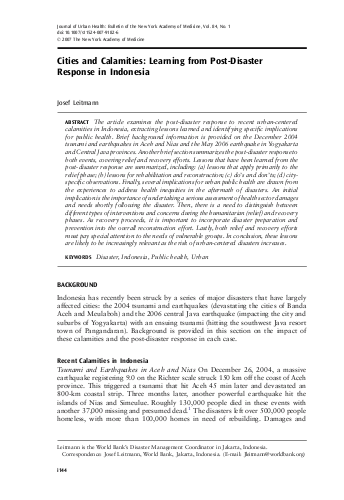
The article examines the post-disaster response to recent urban-centered calamities in Indonesia, extracting lessons learned and identifying specific implications for public health. Brief background information is provided on the December 2004 tsunami and earthquakes in Aceh and Nias and the May 2006 earthquake in Yogyakarta and Central Java provinces. Another brief section summarizes the post-disaster response to both events, covering relief and recovery efforts. Lessons that have been learned from the post-disaster response are summarized, including: (a) lessons that apply primarily to the relief phase; (b) lessons for rehabilitation and reconstruction; (c) do_s and don_ts; (d) cityspecific observations. Finally, several implications for urban public health are drawn from the experiences to address health inequities in the aftermath of disasters. An initial implication is the importance of undertaking a serious assessment of health sector damages and needs shortly following the disaster. Then, there is a need to distinguish between different types of interventions and concerns during the humanitarian (relief) and recovery phases. As recovery proceeds, it is important to incorporate disaster preparation and prevention into the overall reconstruction effort. Lastly, both relief and recovery efforts must pay special attention to the needs of vulnerable groups. In conclusion, these lessons are likely to be increasingly relevant as the risk of urban-centered disasters increases.
Resource collections
- Topics
- UN Habitat - Urban Response Collection
- Urban Response - Urban Crisis Preparedness and Risk Reduction
- Urban Response Collection - Community Engagement and Social Cohesion
- Urban Response Collection - Economic Recovery
- Urban Response Collection - Environment and Climate Change
- Urban Response Collection - Housing, Land and Property
- Urban Response Collection - Urban Crisis Response, Recovery and Reconstruction
- Urban Response Collection - Urban Resilience
